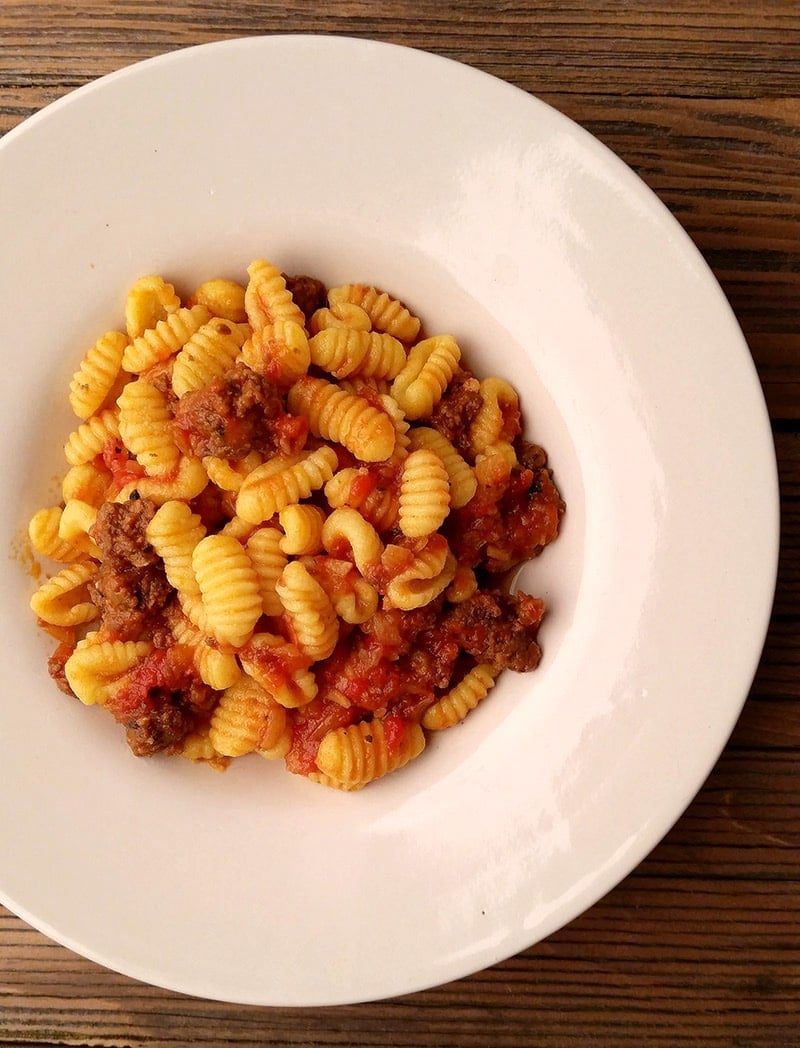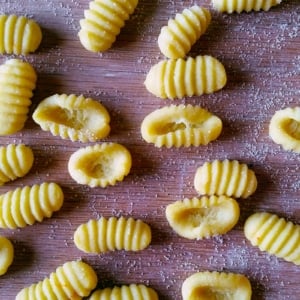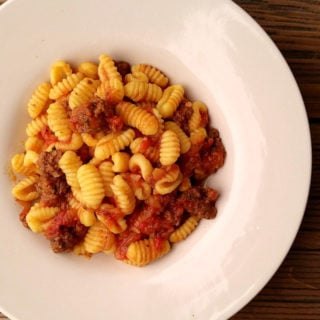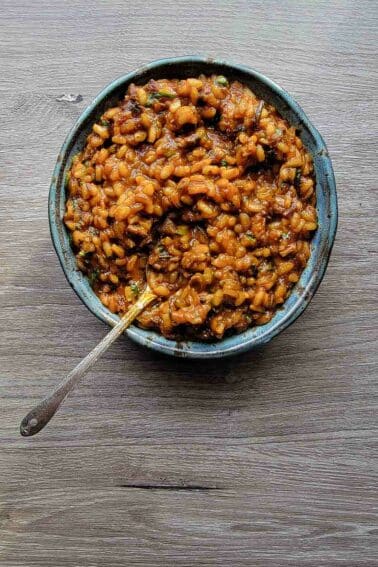As an Amazon Associate I earn from qualifying purchases.

Making pasta is one of my favorite things to do. I am always looking for new shapes to try, especially those you can make with little or no special equipment. Malloreddus, gnocchi from Sardinia, fit the bill nicely.
All you need to make these is either a little gnocchi board, which costs $5. Or hell, roll the dough off the tines of a fork. I use the board, which makes them a bit prettier and more uniform.
The pasta is made from durum semolina and water, with a little saffron tossed in to make the pasta yellow. The ragu is a simple tomato-and-pork pasta sauce, also with a little saffron in there. I used ground wild pig, but any ground meat will work.
What you get is just plain comfort food. Nothing challenging, everything satisfying. Tomato, olive oil. Pork, saffron, and pasta with a nice chew to it.
You can certainly buy malloreddus online, but they’re fun to make.
A few pointers: You want your dough pretty stiff, but pliable. Be sure to knead it a solid 5 minutes, then let it rest inside a plastic bag to keep it from drying out. Once you get a rhythm going, you will be able to knock these out quickly.
If you happen to have any malloreddus left over, they keep in the fridge a day or so. Or you can lay them in one layer on a baking sheet in the freezer, then, once they are frozen solid, you can put them in a plastic freezer bag and they’ll keep, frozen, for several months before they get brittle.
Malloreddus alla Campidanese
Ingredients
PASTA
- 2 cups durum semolina, about 300 grams
- 3/4 cup warm water, about 150 grams
- A pinch of salt
- 2 teaspoons olive oil
- 1/2 teaspoon crushed saffron threads
RAGU
- 1 pound sweet Italian sausage, broken up
- 1 tablespoon olive oil
- 1 large onion, chopped
- 1 tablespoon tomato paste
- 1/2 teaspoon crushed saffron threads
- 1 tablespoon chopped rosemary
- 1 28-ounce can, whole peeled tomatoes
- 3 tablespoons torn-up basil (optional)
- grated pecorino cheese
Instructions
- Start with the pasta. Crumble the saffron in the warm water and let it bloom a few minutes. Mix the flour and salt together in a large bowl. Drizzle the olive oil over this. Pour in the water, making sure you get as many little saffron bits into the dough as possible.
- Knead the dough for 5 minutes, then wrap tightly in plastic wrap. Let this sit on the counter for 1 hour. Or, if you vacuum seal your dough, you can proceed immediately.
- Cut the dough into 8 equal pieces. Keep the pieces you aren't using under the plastic. Roll a piece into a snake about 1/2 inch thick, or a little less. Cut off bits of dough about the size of your thumbnail. Using your thumb, roll each bit off a gnocchi board or off the tines of a fork. Set each dumpling on a baking sheet dusted with more semolina. Repeat with the rest of the dough.
- After you knead the dough and are letting it rest, you can get the ragu started. Put the sausage and olive oil in a large pan and set it over medium-high heat. Brown the sausage, breaking it up into bits as you go.
- Add the onion to the pan and cook the until it softens. Mix in the tomato paste, and, when it is incorporated, add the saffron, bay leaf, rosemary. Take each whole, peeled tomato and tear it up over the pan, letting all the juices fall into the pan. Do this with the whole can, then pour in the remaining contents of the can. Rinse the can with a little water and pour that in, too. Let this simmer uncovered while you make the pasta. Stir it occasionally.
- When the pasta is done, get a large pot of water boiling. Add enough salt to make the water taste salty. Boil the pasta until it floats, then for 1 minute more.
- To serve, put a little of the sauce in a big bowl and add all the pasta. Toss to combine. Serve with a little more sauce on top, garnished with grated cheese.
Nutrition
Nutrition information is automatically calculated, so should only be used as an approximation.






I made homemade sausage for this out of wild boar, then with the gnocchi made by hand it became such a wonderfully memorable dish.
Gotcha! Thanks so much. I’ll let you know how I get on. The great thing is that semolina is longlife so I can make it any time; the bad news is that semolina is longlife so I don’t push myself to make it asap! Cheers again.
I’m a bit confused about saying that the dough needs to rest, while firmly wrapped – I get that bit. But then it says if you can vacuum seal you can start right away. Well surely I’d vacuum seal the dough then immediately re-open to move to next step? What’s the point / how does the process work, please?
Also, after describing the method to make the little pieces, the next step says that while the dough is resting, after kneading, you can start the ragu. Shouldn’t this be written in the other order, so: make dough, rest dough, start ragu; then return to dough, make the little pieces, cook immediately?
I’d be grateful if you would explain! Thanks.
Flash: The vacuum sealing trick is a hack: The process immediately hydrates the dough. Most people don’t do that, though, so I give an alternative. As for the order, hell, make the ragu 3 days beforehand if you want. It’s durable, and just gets better resting in the fridge.